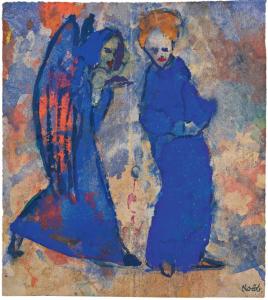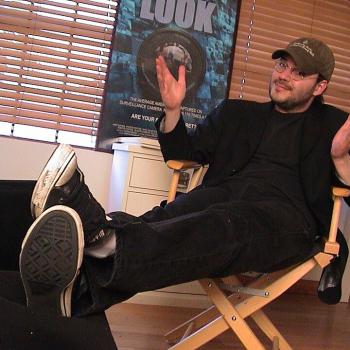
Source: Flickr user cea+
License
There’s an episode from one of my favorite childhood cartoons, Recess (1997-2001), called “The Game.” The game is a puzzle-based quasi-Pokémon rip-off called “Ajimbo” that leaves its players decrepit husks, determined to collect more and more little silver owls and yellow chickens. Their dead eyes, however, did not deter me. I remember wishing we had that game in real life. “Ajimbo” represented a global (or schoolwide) social cohesion that began to disappear by late middle school. The episode closes and opens the same way: a student chucking the final tile away from their school just so that a new kid at a new school can find it and keep the infection going. If only it could’ve been beamed out of the TV and into my lap.
Danny and Michael Phillippou’s Talk to Me (2022) develops this trope for Gen-Z. Mia (Sophie Wilde) is a teenager close to Jade (Alexandra Jensen) and her younger brother, Riley (Joe Bird). Her mom has recently passed and, as we see from her not answering his calls, she holds her father responsible; she spends, as a result, much of her time with Jade, Riley, and her ex-boyfriend (now dating Riley), Daniel (Otis Dhanji). One night they all decide to attend a party where a friend is showcasing a new social-media obsession—a ghastly pale hand, covered in teenage scrawl that, when you touch it, causes screaming, choking, and temporary disfigurement. That is, anyway, if you say “talk to me” followed by “I’ll let you in.” You’ve got 90 seconds. Any longer and no one’s sure what will happen. But during those 90 seconds, man, do you feel great, orgasmic.
Doesn’t look like to me. But what do I know? I’m old.
What’s remarkable is that they not only keep doing this, but love it, enjoy it. Every second is videotaped. We get a lengthy montage set to Australian trap music showing all the ways this portal to the other side can produce hilarity (seizing on the ground so that a dog can come up and kiss you, for example). It’s all quite a bit more degrading than Ajimbo or Cabbage Patch Kids. Soon enough, we have possessions, schizoid episodes, and visions of hell. It takes near death to produce anything but laughter from these kids, though. By then it’s too late.
The Phillippous are Australian YouTubers (known as RackaRacka) who, ironically and successfully, highlight the particular deviances of a young population addicted to constant spectacle (of course we all are now. But they were born in it, molded by it, etc.). Ajimbo may have appealed to me, but there’s no way in (excuse this one) hell I would have kept laughing as friends turned into ghouls and choked, no way I’d have stuck around after the very first time I saw a burn victim or a drowned-bride ghost sitting across from me. This ain’t no Ouija board. It’s a severed hand. Only someone raised on prank videos and honest-to-God giant-believing TikToks could guffaw at a friend made pale by possession. Talk to Me’s premise is so thoroughly indebted to this world of brain-melting spectacle that it makes you believe such a thing is possible. That’s a blood-curdling success.
What’s less successful in the film is its retreat into the world of tired allegory. Another movie in which the bad guy was trauma all along? Not so fast—this time it’s grief! Talk to Me handles the issue better than most with the plot twisting and turning enough to keep your attention. But it goes very wrong when it literalizes the grief, that is, it turns Mia’s mother into a flesh-and-blood (or spirit-and-ectoplasm) zombie in old-hat ghoul make-up, who spells out the evil her daughter ought to do. It’s a shame, because the soundtrack’s use of wood-scratching noises (related to the mom’s death) is eerie and evocative. The sound design is top notch, even if the trap music feels like halfway crookery. Giving evil a form so literal it almost plays like comedy distracts from an otherwise subtle approach to overdone material.
The cinematography suffers from a similar problem: Blue-Light Disease, a common enough ailment for our age of digital cinema, and one doubly endemic among YouTubers-turned-filmmakers. There’s no real perspective, even if some of the gorier scenes do evoke a frightened squeal. The fear doesn’t really build. It diffuses. As Mia’s labyrynthine nightmare gets more and more like an M. Night Shyamalan movie, it gets harder and harder to feel like we should be afraid of anything. Her grief is driving her mad, sure. But what exactly am I scared of? Her visions are constantly shown to be nothing but hallucinations. Her demons are so literal, seen so clearly in pale light, that we know exactly what they look like. I saw them often enough to count the flesh-gaps on their green-white faces. Maybe don’t even show us the ghouls seated across the teens. Maybe just show us the crowd’s reactions in long shot, everyone laughing as the restrained teen with the hand writes in agony. Then the nighttime visits from creepy spirits might burn a little more slowly, a little more brightly.
Still, it’s a fun movie, and one that, despite its gestures at pain/trauma/grief, transcends them, doesn’t concentrate on them any more than is necessary. In that sense, I’d take it over many other A24 horror outings. Call it a step in the right direction. What can I say? It spoke to me.













